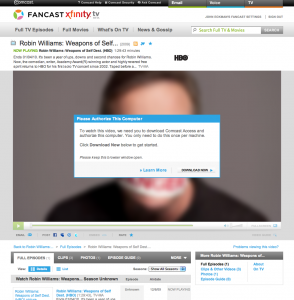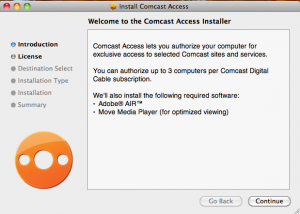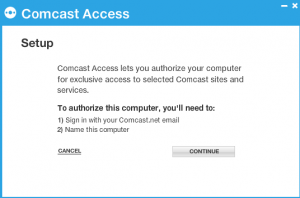There’s been lots of industry buzzz about Time Warner and Comcast’s TV Everywhere plan, which would allow subscribers to fixed-wire cable offerings access to premium content over internet connections, freeing content from the cable box (or cable card). Although it isn’t exactly setting content free on the web, it does seem a positive step in the direction of moving beyond the cable box and cable as the only distribution mechanism for certain kinds of premium content. Users want greater control of what they watch, when they watch it, and where they watch it: TV Everywhere falls short of giving complete control but takes a step in the right direction.
Earlier this month, Comcast launched Fancast XFinity, their branded name for their version of TV Everyehwere. Essentially, XFinity is a distributed authentication system, in which users prove their association to an existing cable subscription, and receive corresponding entitlements to an online video catalog.
Browsing to a video which requires authentication results in this modal dialogue:

Comcast Access (and a specific Movie Player from Move Networks) has to be installed to your machine – and running – to be able to view videos behind the paywall. Comcast Access is an Adobe AIR based application and is available for Mac OS X (intel-based Macs running OS X 10.5 or later) and Windows (XP Service Pack 2, Vista, or 7). No love for Linux and Unix users (which won’t make Comcast Access very popular around Optaros), older PowerPC Macs, or Windows users stuck on Windows 2000. (This also means you’ll have to have or accept AIR being installed on the machine as well). Finally, you’ll need administrative rights on the machine(s) you install Access on – which may restrict some work desktops (a popular place one might want access outside the home).

Users can authorize up to three named computers for access – though it isn’t clear to me yet what happens when you reach your fourth machine (can you un-authorize the first and sawp in the second, as in Apple’s FairPlay DRM in iTunes?).
Once you’ve installed Access (and the Move Networks player) you can authorize the machine it is running on:

The process was relatively painless (though I did have to chat with a customer service rep to find my “comcast email account,” something I set up when subscribing to cable but have never used) on my MacBook Pro, unless you count the pain of accepting yet-another set of digital restrictions management (DRM) shackles. Specifically, the Comcast Access Terms of Service make it clear that this isn’t really TV Everywhere. (I’m reminded of one of my favorite The Princess Bride quotes: “You keep using that word. I do not think it means what you think it means”).
In addition to the platform restrictions, and the requirement that Comcast Access be running as you watch the videos, the TOS notes:
- “You may only install the Software . . . and use Protected Services on Authorized Devices.” – Comcast defines which devices are authorized – they mention PDAs and portable devices, but if your device isn’t on the list you’re not part of everywhere
- On software upgrades: “Upgrades will either be optional, in which case you will be presented with the choice to install such Upgrade, or mandatory, in which case the Upgrade will install automatically and you will be notified after such Upgrade has been successfully installed. By installing and/or using the Software, you consent to such Upgrades being delivered and implemented in such manner.” At least some upgrades might be optional. ;)
- Whose devices can you authorize? “you will not . . . designate as an Authorized Device any device that is not owned and used solely by people then-resident at the service address for your Comcast Digital Cable subscription.” Does this mean that by authorizing my laptop, which I don’t technically own (Optaros does) I’ve violated the TOS? What does then-resident mean: if I’m travelling on business for a week, am I still resident at my service address? What if your roomate moves out – is it your responsibility to de-authorize her authorized devices?
- You also will not “export, import or re-export the Software in violation of any applicable law, rule or regulation of any jurisdiction.” Does traveling with a laptop on which the software is installed constitute export? What if the installer itself is sitting on the desktop? Is it my responsibility to know about the applicable laws in all jurisdictions?
Much (if not all) of this is fairly standard proprietary software TOS fodder, I suspect. DRM systems have to be able to insist on the ability to force updates in case holes in existing versions are discovered and need to be plugged. Controlling the devices (and system software versions) on which the software can be legally installed also helps prevent folks from, for example, hacking a version to run without enforcing DRM.
I wonder how Comcast Access deals with geographic restrictions – can I access premium content to which I have rights as a Comcast customer even while in, say, the UK or Germany where those rights haven’t (potentially) been negotiated?
Or would Fancast, maybe even before requiring Comcast Access authentication, already geolocate my IP and prevent me from requesting material not available in that geography?
Will TV Everywhere be enough to keep cable subscriptions relevant? Frankly, if faster fiber-optic were available at my home address, I’d drop cable in a heartbeat. For me cable is and has been since the mid-nineties primarily about access to the Internet, and only secondarily a way to see a breadth of content on TV. But I recognize I may be the minority there.
Might folks who are not Comcast Cable Subscribers someday be able to purchase a “Fancast XFinity” subscription independent of whether they current have coaxial cable hooked up to their home address?
What will Fancast XFinity, and Comcast’s purchase of NBC Universal, mean for services like Hulu? Is this the beginning of a “return to paywalls” for professional video online?
I hope not. I hope that it’s a first step in the direction of acknowledging the user desire for control, and a first step toward separating the value of the content from the value of the delivery medium. (Just as newspapers aren’t the only or even the best way to consume/distribute news, coaxial cable via subscription isn’t the only or even the best way to consume/distribute professionally created long-form video content.)
Freeing the content from the channel should enable lots of different monetization models, including some form of Freemium access (let users watch the first five episodes of Entourage free, or all free two weeks after original air date) as well un-bundled access (I never want premium sports channels, but many packages include them).
Will the restrictions imposed by the DRM encourage consumers to keep going to unauthorized channels to get content, or will the ease-of-use (so far it has been quite simple) and the low barrier to entry (for subscribers) make this an iTunes moment for online video? (Perhaps this is only possible if/when the service gets extended beyond current cable subscribers and becomes a way to subscribe to premium content online directly).
Honestly I can say that I have been enjoying TV everywhere I go. It sure makes a long subway ride a lot more personalized or a long road trip in the middle of Kansas. I have been using my iPhone with my Sling Adapter since DISH network released it and I love it! I m lucky though, I happen to work for DISH so I was able to get the technology right away but it’s available for all who are on the go!